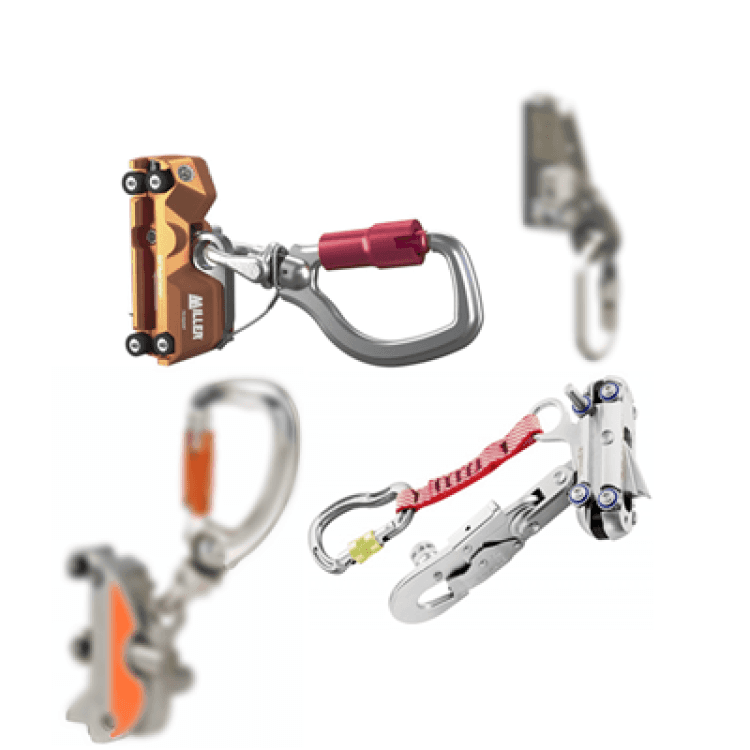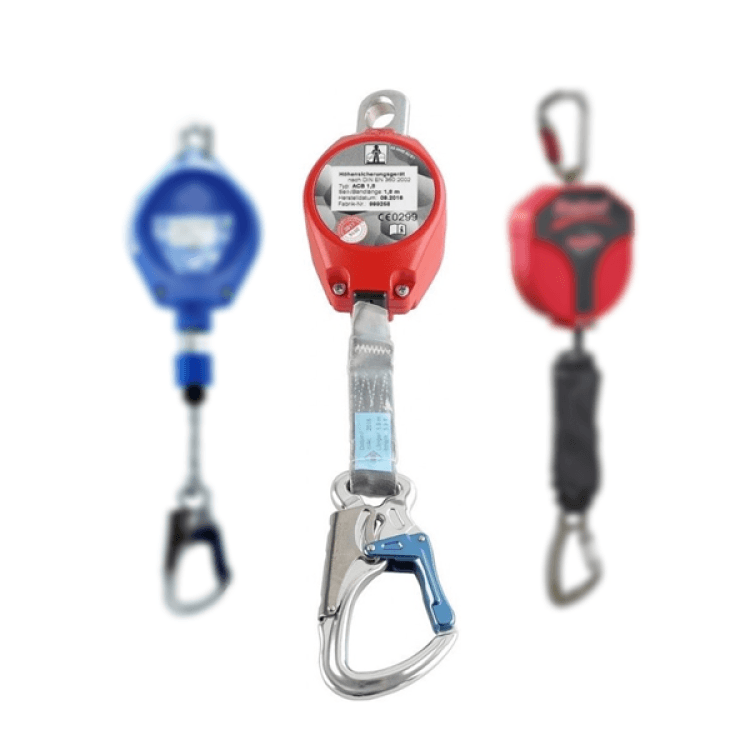We won't leave you alone when you have questions about rules, regulations, standards or laws. We are happy to advise you. You are welcome to contact us by email (anfrage@psa-check.com) or by phone (+49 2309-6009967). We not only test, but for us a test service means to accompany you from the drafting to the end or to carry out these activities.
BGR / GUV-R 198 / DGUV rule 112-198
Use of personal protective equipment against falling
Trade association rules for safety and health at work (BGR)
Preliminary remark
The rules of the accident insurance institutions are primarily aimed at the entrepreneur and are intended to provide him with assistance in the implementation of his obligations under state occupational health and safety regulations or accident prevention regulations, as well as showing ways in which work accidents, occupational diseases and work-related health hazards can be avoided.
If the recommendations contained in the rules are observed, in particular the exemplary possible solutions, the entrepreneur can assume that he has taken suitable measures to prevent occupational accidents, occupational diseases and work-related health hazards. If technical rules have been determined by the committees set up for the purpose of specifying state occupational health and safety regulations, these must be observed as a matter of priority.
The rules of the accident insurance institutions are primarily aimed at the entrepreneur and are intended to provide him with assistance in the implementation of his obligations under state occupational health and safety regulations or accident prevention regulations, as well as showing ways in which work accidents, occupational diseases and work-related health hazards can be avoided.
If the recommendations contained in the rules are observed, in particular the exemplary possible solutions, the entrepreneur can assume that he has taken suitable measures to prevent occupational accidents, occupational diseases and work-related health hazards. If technical rules have been determined by the committees set up for the purpose of specifying state occupational health and safety regulations, these must be observed as a matter of priority.
PSA-Check Poelmann acts according to the new BGR / GUV-R 198 / DGUV rule 112-198 and carries out all prescribed tests for you.
Employer's liability insurance association rules for safety and health at work. Use of personal protective equipment against falls
5.1 General
5.1 General
The personal protective equipment to be used against falls from a height must comply with the relevant regulations for the safety and health protection of the insured at work.
After that, an EC type test must have been carried out for the products. A declaration of conformity from the manufacturer must be drawn up.
A list of the relevant regulations for occupational health and safety is given in Appendix 3.
5.1.1 CE marking
According to § 2 of the PPE Usage Ordinance, only personal protective equipment against falling that bears the CE mark may be selected. The CE marking consists of the abbreviation "CE" (= communauté européene) and a four-digit identification number (monitoring body).
A sample of a declaration of conformity and for the CE marking is shown in Appendix 1.
5.1.2 Marking
For clear identification, each detachable component of a system is clearly, indelibly and permanently marked with at least the following information.
After that, an EC type test must have been carried out for the products. A declaration of conformity from the manufacturer must be drawn up.
A list of the relevant regulations for occupational health and safety is given in Appendix 3.
5.1.1 CE marking
According to § 2 of the PPE Usage Ordinance, only personal protective equipment against falling that bears the CE mark may be selected. The CE marking consists of the abbreviation "CE" (= communauté européene) and a four-digit identification number (monitoring body).
A sample of a declaration of conformity and for the CE marking is shown in Appendix 1.
5.1.2 Marking
For clear identification, each detachable component of a system is clearly, indelibly and permanently marked with at least the following information.
Type and model / designation:
- Names, symbols or other identifiers of the manufacturer or supplier or the trade name.
- Batch or serial number of the component or another sign of verifiability e.g. B. Year of manufacture. Number and year of the corresponding EN standard.
- A pictogram or other indication that users must read the information provided by the manufacturer.
5.1.3 Instructions for use
Written instructions for use (information from the manufacturer) in German are enclosed with each system or component.
5.2 Assessment
Before selecting personal protective equipment against falls from a height, the entrepreneur must carry out an assessment of the personal protective equipment against falls from a height in order to determine whether it
- Offer protection against the dangers to be averted without bringing a greater danger with it
- For the given workplace conditions are suitable, meet the ergonomic and health requirements of the insured, can be adapted to the insured if the type of personal protective equipment against falling, this requires.
5.3 Instructions for the selection
5.3.1 General
5.3.1.1 Pursuant to Section 2 of the PPE Usage Ordinance, the employer must provide the insured with suitable personal protective equipment; He has to hear the insured before making it available
5.3.1.2 When selecting the fall arrest system, the required clear height below the user's standing area must be taken into account. Detailed information on this is given in the manufacturer's instructions for use.
The required clear height is calculated from the respective catching distance and a safety distance of 1m. The safety distance takes into account, among other things, the shifting of the fall arrest eyelet on the belt and the stretching of the belt material (see following examples).
5.3.1.3 Fall arrest systems must not be combined with one another.
A negative influence on the mode of action is possible. For example, adverse effects can occur if fall arrest devices with an additional energy absorber are used.
5.3.1.4 Fall arrest systems are usually designed in such a way that the fall and the fall arrest process take place unaffected. In practice, however, it can happen that the equipment is also exposed to edge stresses, or the anchor device is not above the person, but z. B. can be arranged in the stand level. Specially tested components must be selected for these types of stress.
In the meantime, fall arrest devices, mobile fall arresters including movable guides and lanyards with energy absorbers are available that can withstand certain stresses over an edge. Information on the type of edge stress and the permissible arrangement of the lifting point are contained in the manufacturer's instructions for use.
5.3.1.5 When using personal protective equipment against falling together with other personal protective equipment, it must be ensured that the respective protective effect is not mutually impaired. Examples of combinations of types of PPE:
Combination of head protection and PPE against falls
In cases where there is a risk of head hitting parts of the environment in the event of a fall or during the fall arrest process, it is recommended to use protective helmets with forked chin straps from mountain sports that also meet the requirements of DIN EN 397. This is also necessary if there is a risk of the helmet slipping off due to the fall arrest eyelet sliding up during the fall arrest process.
Combination of respiratory protection and PPE against falls
Orientation studies (see www.dguv.de) determined the mutual influences and the behavior of respiratory protective devices during the fall arrest process. After that, the catching process must always be taken into account for the risk assessment. Short fall distances reduce the risk of impairment of breathing apparatus. Combined, integrated protective equipment is also offered.
Protective clothing and PPE against falls
The integration of full body harnesses in chemical protective suits or other work clothing can be useful.
In addition, the ergonomic features of the combined personal protective equipment must be considered in their entirety in order to avoid overloading the wearer, e.g. due to the total weight of the personal protective equipment, the ambient climate or the workload.
5.3.1.6 A system with a fall arrest device is not permitted for work on materials into which one can sink. Fall arrest devices only work at certain pull-out speeds that cannot be achieved when sinking into fabrics.
5.3.1.7 Mountaineering equipment may only be used to protect people from falling if this equipment also complies with the relevant standards for PPE against falls.
Example: A harness according to DIN EN 12277 must therefore also correspond to DIN EN 361.
Source: bgbau-medien





